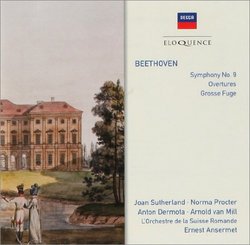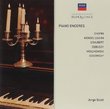| All Artists: Beethoven, Orch Suisse Romande, Ansermet Title: Beethoven: Sym No 9/Overtures Members Wishing: 0 Total Copies: 0 Label: Eloquence Release Date: 8/4/2009 Album Type: Import Genre: Classical Style: Symphonies Number of Discs: 2 SwapaCD Credits: 2 UPC: 028948003976 |
Search - Beethoven, Orch Suisse Romande, Ansermet :: Beethoven: Sym No 9/Overtures
 | Beethoven, Orch Suisse Romande, Ansermet Beethoven: Sym No 9/Overtures Genre: Classical In the latest instalment of the decca ansermet legacy, decca eloquence introduces the swiss conductor's recordings of beethoven - his symphony cycle, overtures and the rare weingartner arrangement of the grosse fuge. They ... more » |
Larger Image |
CD DetailsSynopsis
Album Description In the latest instalment of the decca ansermet legacy, decca eloquence introduces the swiss conductor's recordings of beethoven - his symphony cycle, overtures and the rare weingartner arrangement of the grosse fuge. They are issued as three 2cd sets. Ansermet delivers a lean, muscular performance of the ninth with a slow movement of cool beauty. The youthful choir adds real zest to the finale and aided by a quartet of star soloists (this was joan sutherland's first recording for decca) ansermet gives the choral finale real nobility. Cd2 of this set includes beethoven recordings (selected overtures and the weingartner arrangement of the grosse fuge) by ansermet being released for the first time. Artists: joan sutherland - soprano, norma procter - contralto, anton dermota - tenor, arnold van mill-bass Similar CDs
|
CD Reviews4.5 stars -- not Germanic with magisterial singing Larry VanDeSande | Mason, Michigan United States | 09/02/2009 (4 out of 5 stars) "In regard to the other reviewer, this is the Beethoven Symphony 9 Ansermet recorded in Geneva in April 1959 that has been available in Europe, Japan and USA in various packages over the years. It features the starry vocal quartet of soprano Joan Sutherland, contralto Norma Procter, tenor Anton Dermota and bass Arnold Van Mill. While lovers of the traditional Germanic approach to the "Choral" symphony from the likes of Furtwangler, Klemperer or even Bernstein may be put off by a thin string tone in the beginning and a certain lack of orchestral weight and heft (this was not Ansermet's way as I will explain below), I find this a continually thrilling reincarnation of Beethoven's great symphony, one I can listen to again and again at home.
I would be remiss if I did not admit that Ansermet's stereo recordings of Beethoven was my favorite brand as a young collector in the 1970s -- above and beyond recordings by Bohm, Karajan, Bernstein, Klemperer, Solti and others -- and it has remained so over the years as my tastes have transferred readily to the newer period performance practice methods of Norrington, Immerseel, Gardiner and others. Make no mistake, however; this recording is not a period performance. It is grounded in Ansermet's personal style and a romantic spirit alive everywhere in his era. Today, he would most readily be compared to Martin Perlman, the period practice romantic from Boston. For the uninitated, Ernest Ansermet (born November 11, 1883 died February 20, 1969) was one of Decca's staple of conductors in the 1950s and 1960s when he recorded this set of Beethoven symphonies with L'Orchestre de la Suisse Romande. It repesents the height of his achievement as a Beethoven interpreter. Ansermet created the Swiss orchestra after World War I and recruited its members, so it represented the sound he wanted. Like all the recordings in the Beethoven issuance, Ansermet placed the strings opposite of today -- cellos & basses left and violins right. As a friend and peer to Arturo Toscanini, Ansermet represented many of the same traits as the Italian. Both were literalists with inherent trust in the score -- Ansermet abhorred music that was revised by a composer -- and the two had similarities in the way they performed music. Ansermet's way with Beethoven was represented by moderate speeds, extreme lucidity and clarity, and a romantic inclination. Today, he would be considered a literalit, possibly even a period performer using modern instruments, but with a romantic bent. This 67-minute performance of the great Symphony No. 9 begins a bit shakily with the Swiss orchestra not showing the kind of power and mastery most expect in the opening phrases. A somewhat thin string tone will put off people looking for luxuriance and sometimes wayward woodwinds sounds could affect a listener or two, as well. But this is out of the way pretty quickly and the performance itself is masterful. The back half of the symphony is the best part. The Swiss Radio Orchestra woodwinds shine in the adagio molto e cantabile movement, a section that was split over two records in the old London STS packaging. The finale is a magnificent edifice where the singing can stand with any recording. From his first note, Van Mill is powerfully projected, with depth and resounding bass. Tenor Dermota's first entry could be better but the early music expert soon shows he is in sync with Beethoven's message and manner, performing beautifully with verve. The women are just as good, with Sutherland's bel canto soprano filling the air like a sweet aroma on a moist spring morning. While I have never ascribed to the oft-held theory that the Symphony 9 is one of the artistic pillars of Western civilization, I admit the finale of this piece consistently gives me goose flesh. My chief complaint here, like in the other two sets, is Australian Decca chose to divvy up "the nine" in three boxes for reasons only they know. When I last acquired this set, I had to buy the LPs then have a serivce transfer them to CD. This worked well and I had a five-CD collection of the symphonies. They could have offered that to you here for an inexpensive price and they should have done so. If you are curious about Ansermet, I would recommend acquiring the first set of Symphonies 1-4 before coming here. Those, I believe, give the best idea of what to expect in the later music." |


